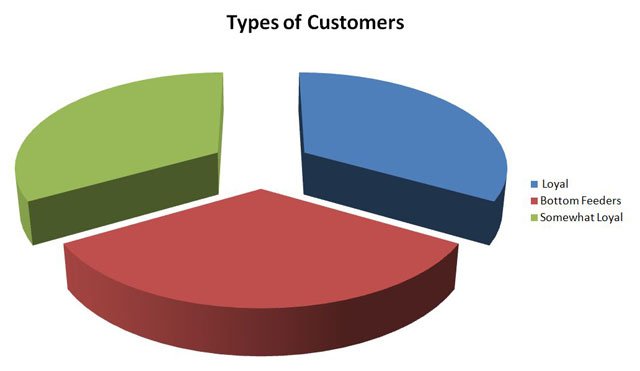Building Long-Term Profitable Customer Relationships, Part 2: Do You Feel Lucky?
/While my business partner, John Enticknap, reveals in his blog posts the methods and tools used in building a more profitable FBO, I’ll be writing about the often overlooked but equally important process of building long-term profitable customer relationships.
My first blog on this subject, Part 1: Are You the Restaurant Owner? was published on Feb. 10.
The following is the second installment:
Part 2: Do You Feel Lucky?
We’ve all seen Clint Eastwood’s Dirty Harry scene when he aims his seemingly empty .44 Magnum, “the most powerful handgun in the world,” in the face of the bank robber and taunts, “You’ve got to ask yourself one question: ‘Do I feel lucky?’ Well do ya, punk?”
FBOs shouldn’t have to feel lucky when putting together their marketing plans to attract new customers, yet during our NATA FBO Success Seminars, I often sense the frustration FBO owners and operators verbalize when we discuss this very subject.
Over the years, FBOs have tried all sorts of things to attract customers. Wine, steaks, bobblehead dolls, free this and free that. Sometimes they get lucky, but mostly they’re just shooting blanks!
Many FBOs, when facing seemingly stiff competition, have done the unthinkable to attract customers. They resort to lowering their price of fuel beyond reason. Yikes!
To be sure, an FBO should always manage its fuel price in order to be competitive and as a component to provide a customer value proposition (CVP). However, nothing good happens when you subjectively lower the price of fuel just to attract customers.
Attracting the Wrong Customer
Besides messing up your profit margin when you arbitrarily lower your price of fuel, you ultimately attract the wrong customer.
Are there really wrong customers in this trusty world of general and business aviation? You bet your .44 Magnum there are.
In my first blog, I wrote that the lifeblood of any FBO is building loyal customer relationships. The success of these relationships can be measured in two ways:
- Are they long-term, and
- Are they profitable?
When you randomly lower fuel prices you get neither long-term customers, nor profitable customers. What you get are bottom feeders, looking for the deal of the day. They tend to flit from one deal to the next. Sure, you may increase your fuel volume for a short period of time, but over the long haul, you’ll be scratching your head, wondering where these newfound customers went.
If you divide your available customer base into thirds, you’ll probably find the following:
- Upper third: Extremely loyal, likes your FBO, knows a good value and pays a fair price for fuel.
- Middle third: Although loyal, is value-conscious, wants a good deal and keeps you on your toes to make sure this value is received.
- Lower third: Bottom feeders. Price is everything. Complains about everything. Flits from one FBO to the next. Famous catch phrase: “What have you done for me lately?”

First of all, getting Loyal customers to leave their present FBO is probably not going to happen in the short term. You may flirt with them a little, but getting a loyal customer to try something new is very difficult. An FBO competitor would have to stub its toe pretty hard to get a loyal customer to leave.
(Note: If you currently have a core of loyal customers, make sure you don’t lose them. Remember why they came to your FBO in the first place, and do everything you can to take care of their needs, wants and desires. Be the restaurant owner.)
Second, more than likely, you’ll get most of your customers from the Somewhat Loyal group. If you are looking to expand your loyal customer base, go fishing in the green pond, not the Bottom Feeder pond.
The Customer Value Proposition (CVP)
So how do you attract these Somewhat Loyal customers to your FBO? Give them a sense of delivering a real customer value proposition (CVP). Done properly, the CVP is the right combination of clean and attractive facilities, fair fuel prices/fees, and good old-fashioned knock-your-socks-off customer service. (We’ll further explore the CVP in another blog post.)
Lastly, it’s critical you get the word out about your CVP. And the way to do that is to deliver it consistently to every customer with whom you have contact. Let them soak it up and remember it, and they will faithfully spread the word.
The general aviation industry is relatively small compared to other industries. Word-of-mouth is a very strong channel of communications, and if you are “lucky” enough to have a customer recommend your FBO to another potential customer, you’re on your way.
Someone once told me you create your own luck, that luck is really the result of working hard, of doing something right consistently over the long haul.
I think that’s pretty good advice.
Next Blog: Building Long-Term Profitable Customer Relationships, Part 3: Don't Forget the Cheese!
Ron Jackson
Ron Jackson is co-founder of Aviation Business Strategies Group and president of The Jackson Group, a PR agency specializing in FBO marketing and CSR training. He is the author of Mission Marketing: Creating Brand Value and co-author of Don’t Forget the Cheese!, the ultimate FBO Customer Service Experience.

